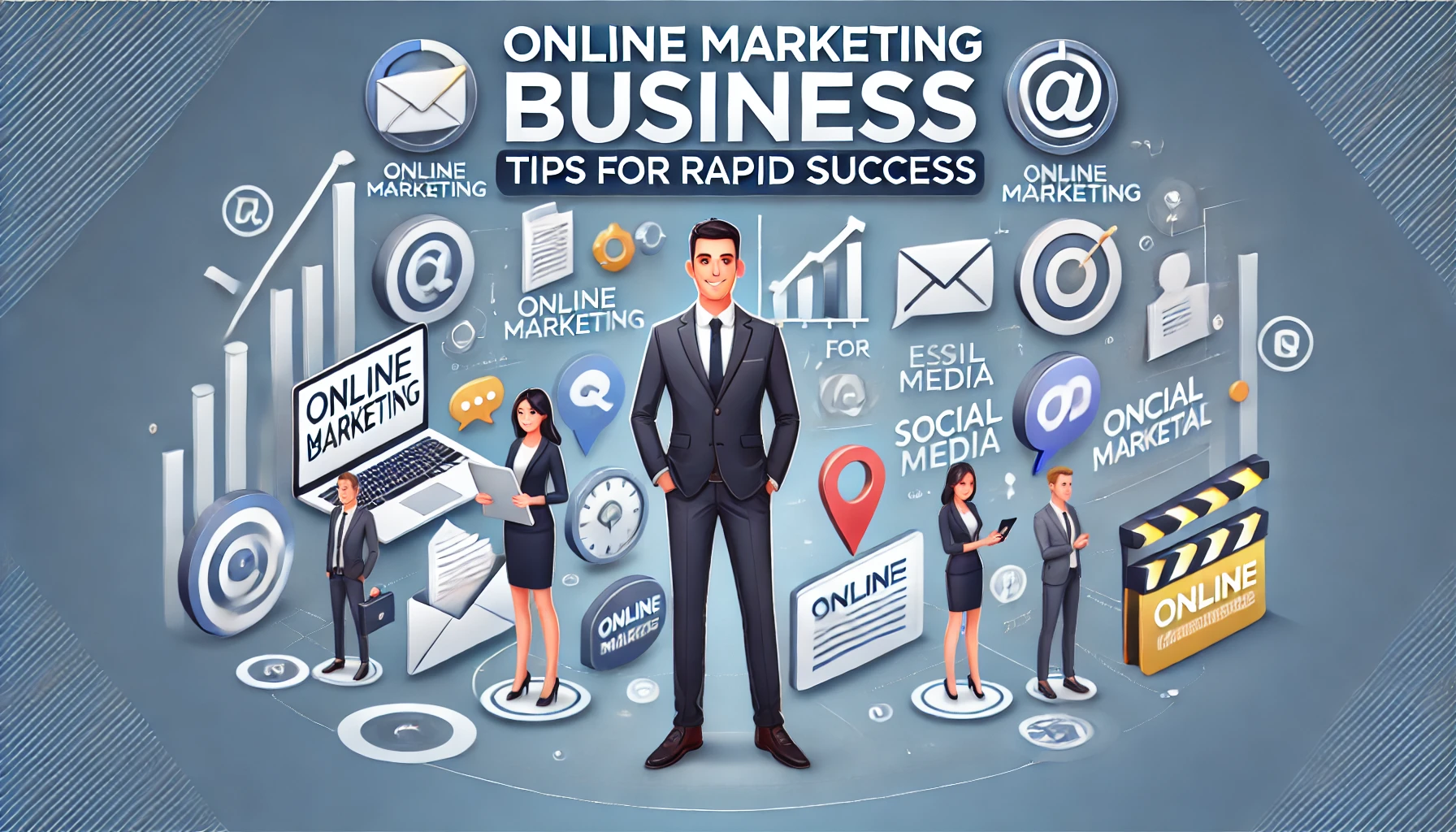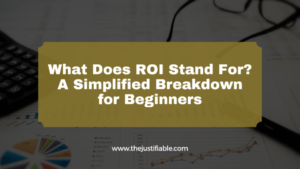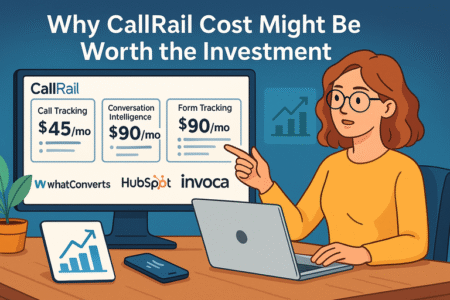Table of Contents
Are you struggling to get rapid success with your online marketing business? Do you find it difficult to create the perfect strategy that drives traffic, builds engagement, and boosts conversions?
You’re not alone. Whether you’re a beginner trying to find your footing or an experienced marketer looking for an edge, mastering online marketing is essential to thrive in today’s competitive digital world.
In this article, we’ll break down actionable tips, from crafting a winning strategy to leveraging SEO and social media, to help you achieve sustainable growth in your online marketing business. Ready to dive in?
Understanding the Foundations of a Successful Online Marketing Business
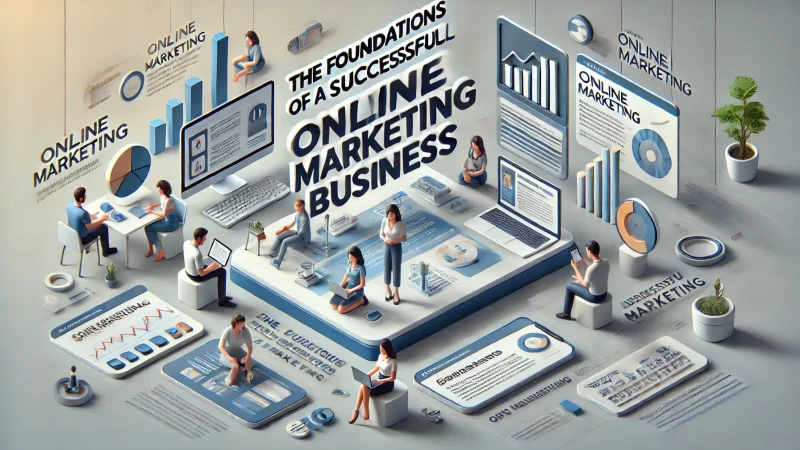
Success in an online marketing business doesn’t happen by accident. It requires a deep understanding of the foundational principles that shape how businesses operate in the digital world. Whether you’re launching a startup or expanding an existing business, these foundations provide the framework for scaling your online marketing efforts effectively.
Understanding the core aspects of online marketing can feel overwhelming at first, but I believe anyone can master it with the right guidance. From understanding what online marketing entails to knowing your audience, these building blocks lay the foundation for achieving sustainable growth and long-term success.
What is Online Marketing and Why Does It Matter for Your Business?
Online marketing refers to the methods used to promote products or services through digital platforms such as search engines, websites, email, and social media. It matters because most consumers are now engaging with brands online, whether they are researching products, reading reviews, or making purchases directly from websites.
I’ve found that a well-executed online marketing strategy can be far more cost-effective than traditional advertising while offering measurable results.
I believe online marketing is vital for all business types, whether you’re a small boutique or a large corporation. It allows you to reach your audience where they spend most of their time—online. Businesses that fail to embrace digital marketing are likely to lose out to competitors who understand its value.
What makes online marketing particularly powerful is its ability to target specific demographics and track your performance. When you know who your customers are and how they behave, you can tailor your messaging to meet their needs effectively. I suggest starting with simple, measurable strategies and building from there.
Additionally, I advise that businesses consider online marketing as a long-term investment. Results may not appear overnight, but consistent efforts over time often lead to higher traffic, better engagement, and increased sales. The key is to be patient and persistent.
Ultimately, the reason online marketing matters so much is that it gives businesses a level playing field. You don’t need a massive budget to make an impact; what you need is creativity, determination, and a willingness to adapt to new trends.
Essential Skills for Mastering the Online Marketing Landscape
In my experience, mastering online marketing requires a specific set of skills. You need to understand how to use digital tools and platforms, create compelling content, and analyze performance data. The good news is that these skills can be learned and developed with practice. I encourage marketers to invest in training or courses to sharpen their abilities.
Learning to analyze data is particularly crucial. I know from experience that understanding the metrics behind your campaigns—such as traffic, engagement, and conversions—gives you the insight needed to make informed decisions. Without this skill, you might struggle to improve your marketing efforts effectively.
Creativity also plays a massive role in online marketing success. Being able to produce engaging content that resonates with your audience will make your business stand out. I suggest experimenting with various content formats, like videos, blog posts, and infographics, to see what works best for your brand.
Another essential skill is adaptability. The online marketing landscape is constantly changing, and I’ve seen many marketers struggle to keep up with the latest trends and updates. Staying updated on industry news and continuously refining your strategy is critical to staying competitive.
I also recommend developing excellent communication skills, both for writing and speaking. Whether you’re creating blog posts, social media updates, or email campaigns, how you convey your message can make all the difference in how it’s received by your audience.
How to Identify and Understand Your Target Audience Online
Understanding your target audience is fundamental to success in online marketing. I’ve noticed that marketers who know their audience well can create more effective, personalized campaigns that drive better results. Start by developing buyer personas based on your ideal customers’ demographics, interests, and behaviors.
Use tools like Google Analytics and social media insights to gather data about your website visitors and followers. I advise analyzing metrics such as age, gender, location, and online habits to build a clearer picture of who your audience is and what they care about.
Once you’ve gathered this data, I suggest categorizing your audience into specific segments. This allows you to target your marketing messages more precisely, tailoring them to address the particular needs or preferences of each group. Personalization is key to keeping your audience engaged and building long-term loyalty.
I believe that another crucial element is understanding where your audience spends their time online. Different platforms attract different user demographics, so identifying which platforms your audience frequents can help you focus your marketing efforts where they will be most effective.
Additionally, listen to your audience’s feedback and adjust your strategy accordingly. I’ve noticed that the most successful marketers continuously refine their approach based on customer feedback and behavior patterns. By understanding your audience, you’ll be better equipped to meet their needs and grow your business.
Creating a High-Impact Digital Marketing Strategy for Your Business
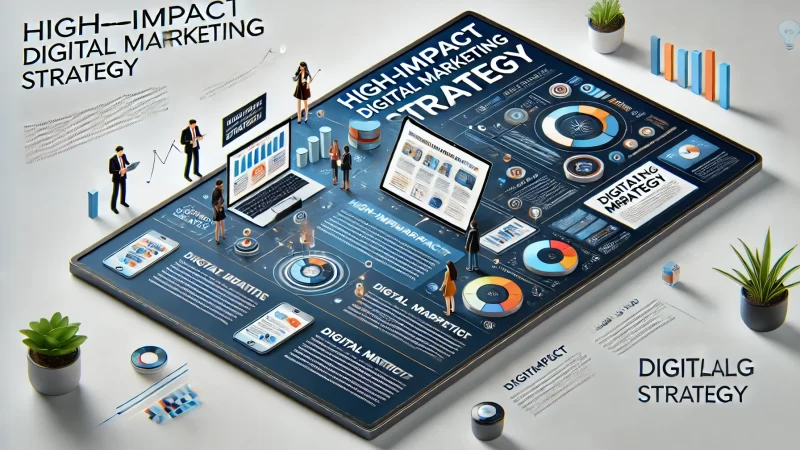
Creating a robust digital marketing strategy is the next crucial step in building a successful online marketing business. A well-crafted strategy ensures that your efforts are aligned with your business goals and helps you achieve results efficiently. In my opinion, planning is half the battle—without a solid strategy, even the best tactics can fall flat.
The purpose of your digital marketing strategy is to create a roadmap that guides your actions and keeps you focused on achieving specific objectives. I suggest regularly revisiting and adjusting your strategy based on performance data and market shifts to stay on track.
Developing SMART Goals for Your Online Marketing Campaigns
Setting SMART (specific, measurable, attainable, relevant, and time-bound) goals is one of the first steps in creating a high-impact strategy. I’ve found that when marketers use SMART goals, they have a clearer sense of direction and can measure their success more effectively. For instance, instead of aiming to “increase sales,” I suggest setting a goal to “increase sales by 15% in the next three months.”
When your goals are specific, it’s easier to track your progress and adjust your strategy as needed. I recommend breaking down larger objectives into smaller, manageable milestones that you can achieve over time. This approach ensures that your campaigns remain focused and actionable.
It’s also important to ensure your goals are realistic and achievable. I’ve seen marketers set goals that are too ambitious, only to be disappointed when they don’t reach them. By setting attainable targets, you’re setting yourself up for long-term success.
I emphasize the importance of aligning your goals with your overall business objectives. Your marketing campaigns should directly contribute to your business growth. For example, if your business goal is to build brand awareness, your marketing goal should focus on increasing website traffic or social media engagement.
Lastly, every goal should have a clear timeline. I believe that setting a deadline creates urgency and helps you stay motivated. When you know you have three months to achieve a particular outcome, you’re more likely to stay focused and take the necessary actions to reach it.
Choosing the Right Marketing Channels for Maximum Exposure
Choosing the right channels is essential to maximizing the impact of your online marketing efforts. From my experience, I recommend starting by understanding which platforms your audience uses most frequently. There’s no point in focusing on a platform like Twitter if your ideal customers spend their time on Instagram.
When deciding on your marketing channels, I suggest considering both your resources and your audience’s behavior. For example, if you have a small team, it may be better to focus on two or three platforms instead of trying to manage five. This ensures that your efforts remain consistent and effective.
I also advise experimenting with a mix of channels, such as social media, email marketing, and content marketing, to find the combination that works best for your business. Different channels have different strengths, and a well-rounded approach will help you reach your audience in multiple ways.
Additionally, I recommend focusing on where you see the highest return on investment (ROI). Analyze which channels are driving the most traffic and conversions and allocate more resources to those platforms. This way, you’ll get the best possible results without spreading yourself too thin.
Lastly, I believe that as your business grows, you can expand into new channels. Start small, perfect your approach, and then gradually build out your digital presence as you gain more experience and resources.
Utilizing Data to Refine and Improve Your Marketing Strategy
Data is your most valuable asset in online marketing, and I cannot emphasize this enough. I recommend using analytics tools to monitor your campaigns’ performance and refine your strategy. Data helps you understand what’s working, what isn’t, and where you need to adjust your efforts for better results.
In my experience, tracking key metrics like website traffic, conversion rates, and engagement allows you to make data-driven decisions. These insights ensure that your campaigns are continuously improving, rather than stagnating. I also advise setting up Google Analytics and other tracking tools early on.
I suggest using A/B testing to experiment with different strategies and find what resonates most with your audience. By testing various elements of your campaigns, such as headlines, calls-to-action, and visuals, you can optimize your content for higher engagement and conversions.
Another key point I want to highlight is the importance of keeping track of your ROI. Understanding which campaigns are delivering the best results allows you to allocate resources more effectively and eliminate underperforming strategies. This approach ensures that you’re getting the most bang for your buck.
Finally, I recommend making data analysis a regular part of your routine. Regularly reviewing your performance will help you identify trends and opportunities for improvement. The more you analyze your data, the more successful your online marketing business will become.
Leveraging SEO for Sustainable Traffic Growth and Visibility
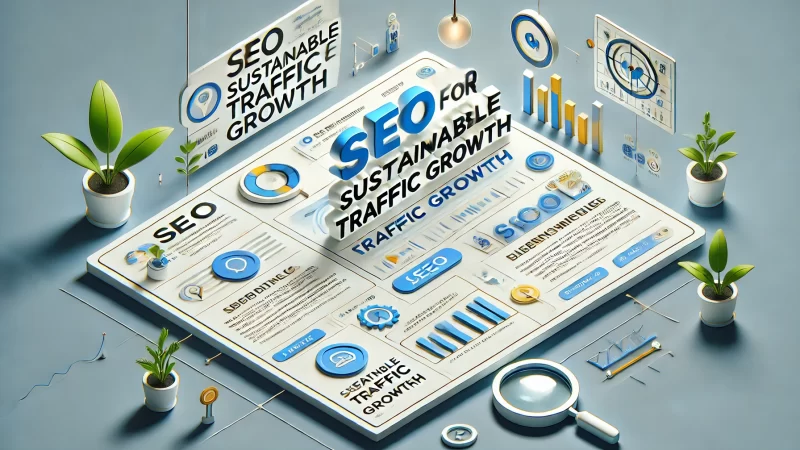
SEO is a game-changer for businesses looking to generate consistent, long-term traffic. When done right, it doesn’t just bring in visitors—it attracts the right kind of audience, people already interested in what you offer. I suggest focusing on SEO to enhance your visibility and reach the top of search results, where the magic happens.
The beauty of SEO is its ability to deliver sustainable results. Unlike paid ads, SEO’s benefits accumulate over time, creating a foundation of organic traffic that can grow exponentially. I believe that mastering SEO not only builds your brand’s credibility but also establishes you as a trustworthy source in your niche.
Why SEO is the Cornerstone of a Successful Online Marketing Business
SEO is at the heart of any online marketing business because it brings in organic traffic—the kind you don’t have to pay for. When done well, SEO helps your website rank high in search results, which translates into increased visibility. I think the real power of SEO lies in its ability to attract potential customers who are actively searching for what you offer.
Another reason SEO is crucial is because it builds trust with your audience. People tend to trust Google’s top results, and if your website appears at the top, they’re more likely to click. I recommend investing time in SEO because it pays off in terms of both traffic and credibility, something that paid ads can’t always provide.
I’ve noticed that SEO also enhances your overall user experience. When optimizing for search engines, you inevitably improve your website’s usability, speed, and mobile-friendliness. This makes your site more appealing not only to Google but to visitors as well, leading to longer visits and higher conversions.
SEO is also cost-effective compared to other marketing strategies. Once you’ve established your ranking, maintaining it requires far less financial input than continuously paying for ads. I think it’s the perfect blend of affordability and effectiveness, making it essential for small businesses looking to scale.
Finally, SEO helps you stay competitive. Your competitors are likely investing in SEO, so if you’re not doing the same, you risk falling behind. I’ve learned that even a small investment in SEO can make a significant difference in staying ahead in the competitive online marketing business landscape.
The Importance of Keyword Research and Competitor Analysis
Keyword research is the backbone of any successful SEO strategy. I recommend using tools like Google SEOPowersuite or SEMrush to identify the terms your target audience is searching for. The right keywords can connect you with people already interested in your services, driving targeted traffic to your site.
Competitor analysis plays a critical role in understanding which keywords are driving traffic to similar businesses. I suggest studying your top competitors’ SEO strategies and identifying gaps you can exploit. This not only helps you find new opportunities but also provides insight into what’s working for others in your niche.
When performing keyword research, focus on long-tail keywords—phrases that are more specific and less competitive. I’ve found that long-tail keywords attract users who are further along in the buying journey, making them more likely to convert. While they may have lower search volumes, their conversion potential is often higher.
Don’t overlook the importance of search intent. I emphasize understanding what users want when they type in a keyword. Is it informational, navigational, or transactional? By aligning your content with their intent, you can create more relevant content that better satisfies search queries and boosts your rankings.
Lastly, I suggest regularly updating your keyword list. Search trends change, and what worked last year may not work today. By continuously analyzing keyword performance and making adjustments, you can stay ahead of the curve and maintain strong SEO results over time.
How to Build High-Quality Backlinks to Increase Domain Authority
Backlinks are essential for building domain authority, a key factor in SEO success. I’ve noticed that sites with high-quality backlinks tend to rank higher because search engines view them as trustworthy and credible. But not all backlinks are created equal—I recommend focusing on earning links from reputable, relevant websites in your niche.
Guest posting is a powerful way to build backlinks. By contributing high-quality content to industry blogs, you not only gain exposure to a wider audience but also secure valuable links back to your website. I advise reaching out to blogs and publications that align with your business to maximize the impact of your guest posts.
Creating shareable content is another effective strategy. When you create informative, engaging content, people are more likely to link to it naturally. I’ve found that infographics, research studies, and how-to guides often perform well in terms of gaining backlinks. Invest time in crafting content that others will find valuable and shareable.
In addition, I recommend building relationships with influencers and industry leaders. When influencers link to your site or mention your brand, it not only boosts your credibility but also encourages others to do the same. Networking within your industry can open doors to new backlink opportunities.
Finally, focus on internal linking as well. While external links are crucial, internal links help search engines better understand the structure of your website. By linking to relevant pages within your site, you can guide both search engines and users through your content, improving your overall SEO performance.
Mastering Social Media Marketing for Brand Awareness and Engagement
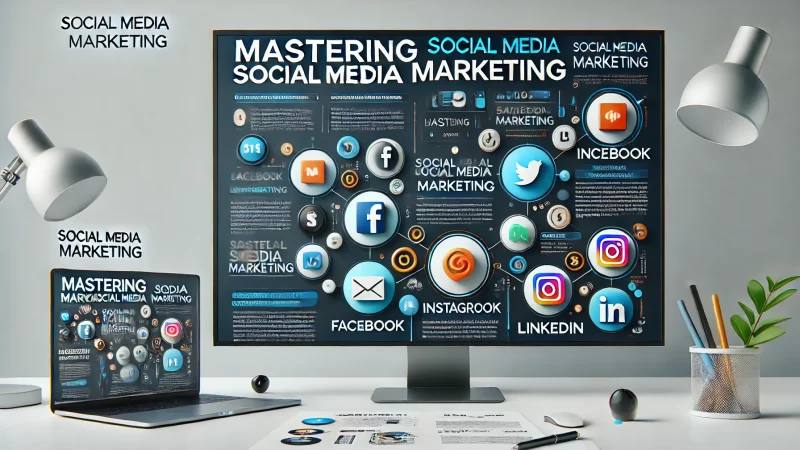
Social media marketing is one of the most effective ways to build brand awareness and foster engagement. I believe that businesses that master social media can turn casual followers into loyal customers. With billions of users active on platforms like Facebook, Instagram, and LinkedIn, the potential to reach your audience is limitless.
Social media also allows for direct interaction with your audience, something I think is priceless in today’s marketing landscape. Engaging with your followers builds trust, encourages loyalty, and helps you gather valuable insights that can improve your overall marketing strategy.
Picking the Right Social Media Platforms for Your Business Goals
Not all social media platforms are the same, and I recommend selecting the ones that align with your business goals. For example, Instagram is perfect for visual content and connecting with younger audiences, while LinkedIn is great for B2B networking and thought leadership. I suggest focusing on the platforms where your target audience spends the most time.
In addition to audience alignment, consider the type of content that works best on each platform. Facebook, for instance, supports a variety of content formats, including videos, articles, and images. I advise experimenting with different content types to see what resonates most with your audience.
I’ve learned that consistency is key in social media marketing. Whether you’re posting daily updates on Twitter or sharing weekly blog posts on LinkedIn, maintaining a regular posting schedule keeps your audience engaged. Tools like Buffer or Hootsuite can help automate your posts, ensuring that you stay consistent.
When selecting platforms, I recommend starting with one or two, especially if you’re managing your social media efforts on your own. It’s better to excel on a few platforms than to spread yourself too thin across several. As your business grows, you can expand into new platforms.
Lastly, I believe that you should constantly evaluate which platforms are delivering the best results. Social media trends shift, and what works today might not work tomorrow. By tracking engagement and conversion rates, you can adapt your strategy and continue to meet your business goals.
Proven Social Media Content Strategies to Boost Engagement
One of the best ways to boost engagement is by creating content that encourages interaction. I suggest using polls, quizzes, or question-based posts to spark conversations with your followers. These interactive formats not only engage your audience but also provide insights into their preferences and opinions.
Visual content performs particularly well on social media. I’ve noticed that videos, images, and infographics tend to receive more likes, shares, and comments than text-based posts. I recommend using high-quality visuals to grab attention and stand out in crowded social feeds.
Another content strategy I find effective is storytelling. Sharing your brand’s story or customer success stories helps build a connection with your audience. I advise creating content that humanizes your brand and gives followers a reason to care about what you do.
I also recommend incorporating user-generated content (UGC) into your strategy. When customers share photos or testimonials featuring your products, reposting them can boost engagement and build trust. People love seeing real-life examples, and UGC provides social proof that your brand delivers on its promises.
Finally, consider using hashtags strategically. Hashtags help expand the reach of your posts by making them discoverable to people who aren’t already following you. I suggest using a mix of popular and niche-specific hashtags to maximize your visibility and attract new followers.
Tracking Key Metrics: Measuring the ROI of Your Social Media Efforts
To measure the success of your social media campaigns, I recommend tracking key metrics such as engagement, reach, and conversion rates. Tools like Zoho Analytics and platform-specific insights allow you to see how your content is performing. By understanding these metrics, you can adjust your strategy and improve your results.
Engagement metrics, like likes, comments, and shares, provide insights into how your audience is interacting with your content. I suggest focusing on posts that generate high engagement and replicating their success in future campaigns. High engagement often indicates that your content resonates with your audience.
Reach is another important metric. It tells you how many people have seen your posts, regardless of whether they interacted with them. I recommend using reach metrics to evaluate the effectiveness of your hashtags, posting times, and content types.
Conversion rates are critical when assessing the ROI of your social media efforts. I advise tracking how many of your social media visitors are taking actions such as signing up for a newsletter, making a purchase, or filling out a contact form. This helps you understand whether your social media efforts are driving tangible results.
I also believe that tracking follower growth over time is essential. While not every follower translates into a customer, growing your social media audience increases your brand’s visibility and potential reach. I suggest monitoring follower growth alongside other key metrics to get a comprehensive view of your social media performance.
Content Marketing: Creating Value-Driven Content to Attract Customers
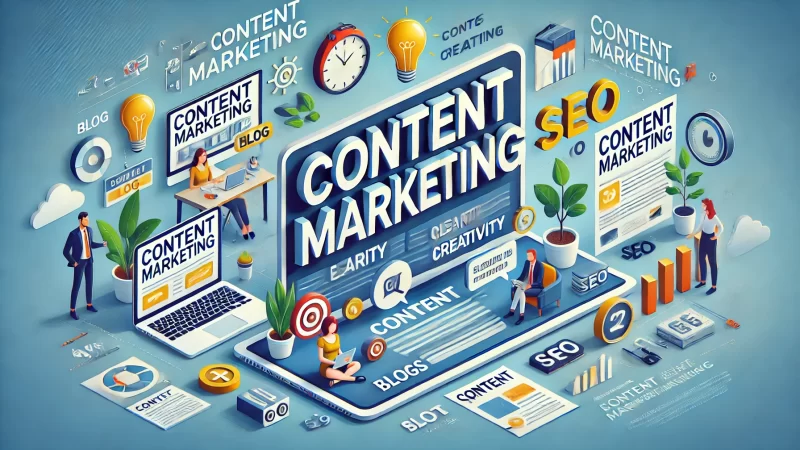
Content marketing is all about providing value to your audience. When done correctly, it attracts potential customers by offering solutions, insights, or entertainment that aligns with their needs. I’ve learned that the key to successful content marketing lies in creating material that solves problems and resonates with the audience, not just promoting products.
By focusing on value-driven content, businesses can establish themselves as authorities in their niche. This builds trust and keeps customers coming back for more. I suggest thinking of content marketing as a long-term strategy that nurtures relationships and leads to organic growth, rather than just a one-off sales tool.
How to Create Content That Solves Problems and Engages Audiences
When creating content, the first step is to identify your audience’s pain points. I recommend researching common challenges or questions your target audience faces. Content that addresses these issues will immediately attract attention and position your brand as a valuable resource. The more you solve problems, the more trust you build.
In addition, I suggest using real examples or case studies to illustrate solutions. Audiences respond well to practical, actionable advice that they can implement right away. By sharing real-world applications of your product or service, you give your content more weight and make it more relatable to your audience.
To keep readers engaged, I believe it’s important to mix up your content formats. Use a combination of articles, videos, and infographics to keep things fresh. This variety not only keeps the audience interested but also ensures that you cater to different learning styles, making your content accessible to a wider range of people.
Another way to boost engagement is to encourage interaction. I suggest including calls to action (CTAs) that invite readers to comment, share their experiences, or ask questions. Engagement increases when audiences feel involved and part of the conversation, rather than just passive consumers of content.
Lastly, remember that content doesn’t have to be long to be effective. Short, concise pieces that provide immediate value can be just as impactful. I recommend focusing on clarity and simplicity, ensuring your message gets across quickly and efficiently while still addressing your audience’s needs.
Blogging, Videos, and Infographics: Different Forms of Content Marketing
Blogging remains one of the most effective forms of content marketing. I find that blogs allow businesses to dive deep into topics, provide detailed solutions, and optimize for search engines. A well-maintained blog can drive consistent traffic to your site, improving both visibility and engagement over time.
Videos are another powerful content form. People love visual content, and I’ve noticed that video marketing often drives more engagement than text-based content alone. Whether it’s tutorials, interviews, or product demos, videos allow you to showcase your brand’s personality and make complex information easier to digest.
Infographics are ideal for presenting data in a visually appealing way. I suggest using infographics to simplify statistics, research findings, or step-by-step processes. They’re highly shareable on social media and can quickly capture attention, making them an excellent tool for boosting visibility and spreading your message.
Another great aspect of infographics is their versatility. I’ve seen businesses repurpose blog content into infographics or vice versa, creating multiple forms of content from one idea. This allows you to reach different segments of your audience while maximizing the value of your original content.
Finally, integrating different content types—blogging, videos, and infographics—into a cohesive strategy can enhance your brand’s online presence. I recommend experimenting with various formats to see what resonates most with your audience and finding a balance that works for your business.
Building an Effective Content Calendar to Maintain Consistency
A content calendar helps maintain consistency, which is critical in content marketing. I suggest starting with a plan that outlines your content goals, target audience, and publishing frequency. This keeps you organized and ensures you’re consistently delivering value to your audience, which builds trust over time.
Consistency doesn’t just apply to publishing schedule—it’s also about maintaining a consistent tone and message. I recommend developing a brand voice that reflects your company’s values and resonates with your audience. Stick to this voice across all platforms, whether it’s blogs, videos, or social media.
In my experience, a content calendar also helps align your content with larger business goals. For example, if you’re launching a new product, your content should focus on related topics in the lead-up to the launch. Planning content in advance ensures that everything is aligned with your overall marketing strategy.
When creating a content calendar, I suggest incorporating key dates, such as holidays or industry events, to capitalize on trending topics. This keeps your content timely and relevant, allowing you to engage your audience more effectively. Staying on top of trends can also help you tap into larger conversations.
Finally, I believe flexibility is key. While a content calendar provides structure, it’s important to remain adaptable. Be prepared to adjust your schedule if a new opportunity arises or if certain content performs better than expected. The ability to pivot can make a huge difference in your content marketing success.
Boosting Conversions With Strategic Email Marketing
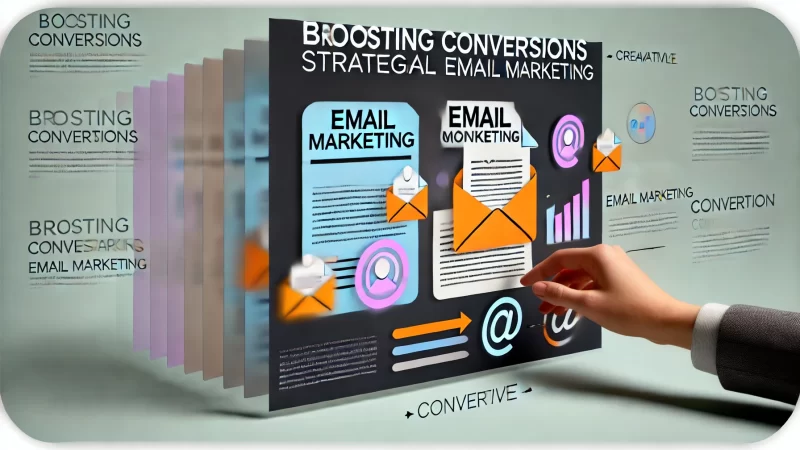
Email marketing remains one of the most effective tools for boosting conversions. I suggest using it strategically to nurture leads and guide them through the sales funnel. By providing personalized, valuable content directly to your audience’s inbox, you can build stronger relationships and encourage action.
What I love about email marketing is its versatility. Whether you’re sending promotional offers, newsletters, or educational content, emails can be tailored to meet the specific needs of your subscribers. This personalization drives higher engagement, ultimately leading to increased conversions.
Building a High-Converting Email List: Where to Start
To build a high-converting email list, I recommend offering something valuable in exchange for sign-ups. This could be a free ebook, discount code, or access to exclusive content. The more value you provide, the more likely people are to subscribe and engage with your emails down the line.
It’s also crucial to target the right audience from the beginning. I suggest using opt-in forms on your website, social media, and landing pages that clearly communicate the benefits of joining your email list. Make sure your offer aligns with the needs and interests of your target audience to ensure high-quality subscribers.
Another tip is to segment your list based on behaviors or demographics. Segmentation allows you to tailor your messages more effectively, leading to higher engagement and conversions. I find that personalized emails that address specific customer needs perform significantly better than generic, one-size-fits-all campaigns.
Focus on quality over quantity. I recommend cleaning your email list regularly to remove inactive subscribers. A smaller, engaged list is far more valuable than a large list of unresponsive contacts. This also helps improve your email deliverability, ensuring your messages reach the right inboxes.
Finally, make sure your sign-up process is simple and user-friendly. I’ve noticed that complicated forms can deter potential subscribers. Keep it short, requesting only the essential information, and highlight the benefits of signing up to encourage conversions.
Crafting Subject Lines That Drive Higher Open Rates
Subject lines are the first thing your audience sees, so I recommend spending time crafting compelling ones. A strong subject line can significantly increase open rates. Use power words and create a sense of urgency to entice readers to click. The goal is to spark curiosity without being misleading.
Personalization is key. I’ve found that including the recipient’s name or referencing their past behavior (e.g., “Check out our latest offers just for you!”) can boost open rates. When people feel the email is relevant to them personally, they’re more likely to engage with it.
Keep subject lines short and to the point. Most people scan their inboxes quickly, so I suggest aiming for fewer than 50 characters. A clear, concise subject line that communicates the value of the email will stand out better than a long-winded one that gets cut off in mobile inboxes.
Testing is another essential part of improving your subject lines. I advise running A/B tests to see which subject lines perform best. Experiment with different formats, tones, and power words to learn what resonates most with your audience and use that data to optimize future emails.
Finally, don’t forget to align the subject line with the content of the email. There’s nothing worse than a clickbait subject line that doesn’t deliver on its promise. I recommend keeping the subject line honest and relevant to the email’s content to build trust with your subscribers.
Automated Email Workflows for Nurturing Leads and Driving Sales
Automated email workflows save time while ensuring consistent communication with your audience. I suggest setting up workflows that nurture leads through the sales funnel. For example, a welcome series can introduce new subscribers to your brand, while a cart abandonment series can remind customers to complete their purchases.
When creating workflows, I recommend focusing on personalization. Tailor the emails based on customer behaviors, such as past purchases or browsing history. Automated workflows that feel personalized are far more effective at driving conversions than generic, one-size-fits-all messages.
I’ve noticed that triggered emails, such as birthday offers or post-purchase follow-ups, can create a deeper connection with your audience. These personalized touchpoints show that you’re paying attention to your customers and can encourage repeat purchases, boosting overall sales.
Another tip is to ensure that each email in the workflow serves a specific purpose. I suggest guiding the recipient through a clear journey, whether it’s moving them closer to a purchase or providing valuable resources that build trust. Each step should add value and encourage the recipient to take action.
Finally, continuously optimize your workflows based on performance data. I recommend analyzing open rates, click-through rates, and conversion rates to identify areas for improvement. Regularly refining your automated email workflows will help you achieve better results and drive more sales over time.
Using Paid Advertising to Scale Your Online Marketing Business
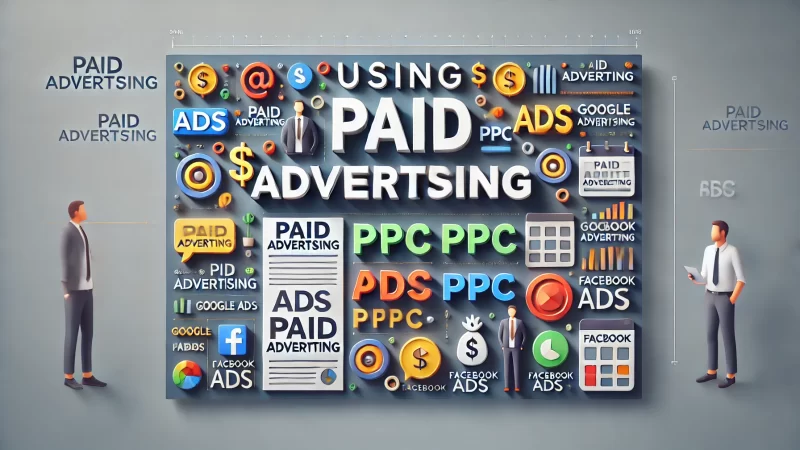
Paid advertising is a powerful tool that allows businesses to reach targeted audiences quickly. I suggest using paid ads to scale your online marketing business when organic growth isn’t enough. By allocating a portion of your marketing budget toward platforms like Google and Facebook Ads, you can accelerate your brand’s exposure and attract more potential customers.
Scaling with paid ads is efficient because it offers precise targeting and measurable results. However, it’s crucial to approach it strategically. I recommend regularly tracking your campaign performance and adjusting your strategy to maximize ROI. Paid ads can help you scale, but only if managed with careful planning and continuous optimization.
Google Ads vs. Facebook Ads: Which One Is Better for Your Business?
Choosing between Google Ads and Facebook Ads depends on your business goals and audience. Google Ads is great for capturing search intent. When users search for specific products or services, your ad can appear at the top of the search results. I recommend Google Ads if you’re looking to capture customers ready to make a purchase.
On the other hand, Facebook Ads are more suited for audience targeting based on interests, behaviors, and demographics. If you’re focused on building brand awareness or reaching a broader audience, I believe Facebook Ads may be a better choice. They offer extensive targeting options that let you connect with users in their social environment.
I’ve found that both platforms serve different purposes. Google Ads tends to perform better for immediate conversions, while Facebook excels in nurturing prospects over time. I recommend testing both platforms to see which aligns best with your business goals and provides the best returns.
Consider your budget. I suggest starting with smaller campaigns on both platforms to evaluate their performance. This allows you to gather data and decide where to allocate more of your ad spend without committing too heavily upfront. The key is finding what works best for your audience.
Ultimately, the best platform is the one that delivers the results you need. I advise regularly analyzing your ad performance on each platform and adjusting your budget to maximize effectiveness. Don’t be afraid to pivot if one platform is driving better results than the other.
Retargeting Campaigns: Bringing Back Lost Prospects and Conversions
Retargeting campaigns are an effective way to re-engage prospects who didn’t convert on their first visit to your site. I suggest using retargeting ads to remind potential customers of products or services they’ve shown interest in. These campaigns can be particularly useful in turning lost prospects into paying customers.
Retargeting allows you to stay top-of-mind for prospects. I find that it works especially well for businesses with longer sales cycles, where customers need more time to make purchasing decisions. Retargeting nudges them back toward your brand, making it easier for them to follow through.
For maximum impact, I recommend personalizing your retargeting ads. Dynamic ads that showcase specific products viewed by the prospect can significantly improve conversion rates. When prospects see the exact items they’re interested in, they’re more likely to return and complete the purchase.
Retargeting also provides opportunities to offer incentives. I’ve seen great success when businesses use retargeting ads to offer limited-time discounts or promotions. These incentives create urgency and encourage customers to take action, making them a powerful tool for closing sales.
Lastly, don’t overdo it. I suggest setting frequency caps to avoid overwhelming your audience with retargeting ads. Too many ads can lead to ad fatigue, where users start ignoring or blocking your content. Striking a balance is key to keeping your prospects engaged without annoying them.
Budgeting for Paid Ads: How to Maximize Your ROI
Effective budgeting for paid ads ensures that you’re getting the most value out of every dollar spent. I recommend starting with a clear budget in mind and regularly reviewing your ad performance to optimize your spend. Prioritize campaigns that drive the highest ROI and allocate more funds to the platforms that perform best.
It’s important to set realistic goals. I advise breaking down your budget based on specific objectives—whether it’s brand awareness, lead generation, or direct sales. Each goal may require different levels of spending, so plan accordingly to ensure your budget aligns with your business priorities.
I’ve found that regularly optimizing campaigns can help stretch your budget further. I recommend monitoring metrics such as cost-per-click (CPC) and conversion rates to identify areas for improvement. Testing different ad creatives and targeting options can also help you refine your approach and maximize ROI.
Another tip is to avoid spreading your budget too thin. I believe it’s better to focus on a few high-performing campaigns than to try and cover too many platforms at once. Concentrating your ad spend allows you to gather more meaningful data and make better-informed decisions.
Lastly, consider scaling gradually. I suggest starting with smaller ad spends and increasing your budget as you see positive results. This approach helps minimize risks and ensures that you’re investing in strategies that are proven to deliver the highest returns.
Analyzing and Optimizing Your Online Marketing Efforts for Growth
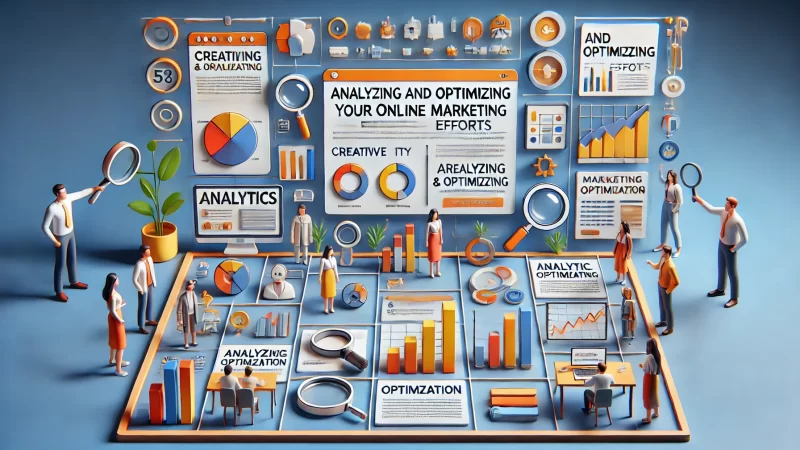
Regular analysis of your marketing efforts is essential for long-term growth. I recommend reviewing your campaigns frequently to see what’s working and what’s not. By identifying areas of improvement, you can make data-driven adjustments that enhance performance and increase your ROI. Optimization is key to staying competitive in a constantly evolving market.
Tracking the right metrics will give you valuable insights into your audience’s behavior. I suggest using tools like Google Analytics and Facebook Insights to monitor traffic, conversions, and user engagement. This data helps you refine your strategy and make informed decisions to drive consistent growth.
Understanding Key Performance Indicators (KPIs) in Digital Marketing
Key performance indicators (KPIs) are the metrics that show how well your marketing efforts are working. I suggest focusing on KPIs that align with your business goals, such as website traffic, conversion rates, and customer acquisition costs. These indicators help you gauge the effectiveness of your campaigns and guide your optimization efforts.
I believe that tracking engagement metrics like click-through rates (CTR) and bounce rates is also essential. High engagement indicates that your content resonates with your audience, while high bounce rates may suggest that your landing pages need improvement. Keeping an eye on these metrics allows you to make quick adjustments.
In addition to engagement, I recommend monitoring ROI-based KPIs like return on ad spend (ROAS) and customer lifetime value (CLV). These metrics give you a clearer picture of the financial impact of your campaigns and help you identify where to allocate your marketing budget for maximum returns.
I’ve found that customer retention metrics, such as repeat purchase rates, are equally important. These KPIs provide insights into how well your marketing efforts are nurturing long-term relationships with your audience. Building loyalty is often more cost-effective than acquiring new customers, so don’t overlook this metric.
Lastly, I suggest tracking lead generation KPIs, such as the cost per lead (CPL) and lead-to-customer ratio. These figures help you assess the efficiency of your marketing funnel and whether you need to optimize your lead nurturing strategies to boost conversions.
How to Use A/B Testing to Improve Campaign Performance
A/B testing is a valuable tool for improving campaign performance. I recommend testing one variable at a time, such as headlines, images, or calls-to-action, to see which version performs better. By comparing results, you can identify the most effective elements and optimize your campaigns for better results.
I’ve noticed that small changes can lead to significant improvements. For example, testing different ad copy or landing page designs can boost conversions. I suggest experimenting with various layouts, colors, and messaging to see what resonates most with your audience.
To get the most out of A/B testing, I advise setting clear goals for each test. Whether you’re looking to increase clicks, conversions, or engagement, having a specific objective allows you to measure success accurately. Without a clear goal, it’s hard to know if the changes are truly making a difference.
It’s important to let your tests run long enough to gather meaningful data. I recommend avoiding premature conclusions based on small sample sizes. Allow the test to run for a sufficient period to ensure that the results are statistically significant and can be applied to future campaigns.
Lastly, keep a record of your A/B testing results. I find that documenting what works and what doesn’t helps you build a knowledge base for future campaigns. Over time, you’ll develop a better understanding of your audience’s preferences and optimize your marketing strategies accordingly.
Adjusting Your Strategies Based on Analytics and Feedback
Analytics and customer feedback are invaluable for improving your online marketing efforts. I suggest regularly reviewing your data to identify trends and opportunities for improvement. Whether it’s low conversion rates or high customer engagement, the insights you gather will guide you in adjusting your strategies for better results.
When analyzing data, focus on both high-level trends and granular details. I recommend looking for patterns in customer behavior, such as the most common conversion paths or frequently visited pages. These insights can help you refine your marketing funnel and enhance the customer journey.
Customer feedback is another crucial source of information. I advise paying attention to reviews, surveys, and social media comments to understand how your audience perceives your brand. This feedback can highlight areas where you’re excelling and where you need to improve, allowing you to make more informed marketing decisions.
Once you’ve gathered data and feedback, I suggest creating an action plan. Prioritize the areas that need immediate attention, whether it’s optimizing your ad targeting or improving website usability. Having a clear plan ensures that you’re making data-driven decisions that will lead to tangible improvements.
Finally, remain flexible and open to change. I’ve learned that the most successful marketers are those who continuously adapt their strategies based on real-time insights. The online marketing landscape is always evolving, and staying ahead requires constant refinement of your approach.
Frequently Asked Questions (FAQ)
What is the best way to start with paid advertising for my online marketing business?
The best way to start is by setting a clear budget and specific goals. I recommend testing different platforms like Google Ads and Facebook Ads with small campaigns to see what works best for your target audience. Focus on one or two key platforms initially, monitor performance, and adjust your strategy based on results.
How do I choose between Google Ads and Facebook Ads for my business?
Choosing between Google Ads and Facebook Ads depends on your audience and business goals. I suggest using Google Ads for search intent, as it targets people actively searching for your product. Facebook Ads are better if you want to create brand awareness and target users based on interests, behaviors, and demographics.
How can I improve the ROI of my paid ad campaigns?
Improving ROI involves continuous optimization. I recommend regularly reviewing metrics like conversion rates and cost-per-click, running A/B tests on ad creatives, and refining your targeting options. Focus on campaigns that deliver the best results and allocate more budget to high-performing ads while cutting underperforming ones.
What are some key metrics to track for paid advertising campaigns?
Key metrics to track include click-through rates (CTR), conversion rates, return on ad spend (ROAS), and cost-per-click (CPC). I also suggest monitoring engagement rates for social ads and customer acquisition costs to evaluate how efficiently your ads are converting prospects into customers. These metrics help guide decisions on optimizing your campaigns.
What is retargeting, and how does it help in online marketing?
Retargeting involves showing ads to people who have already visited your website but didn’t complete a desired action, such as making a purchase. I find it highly effective for bringing back lost prospects and increasing conversions, as it keeps your brand top-of-mind for people who are already familiar with your product or service.
How often should I analyze and optimize my online marketing efforts?
I advise analyzing your marketing performance at least weekly, especially for paid ad campaigns. Regular monitoring helps you spot trends, identify opportunities, and make timely adjustments. The frequency can vary depending on the campaign size, but staying proactive with your analysis ensures that you’re continuously improving your marketing efforts.


